![]()
![]()
![]()
Use LEFT and RIGHT arrow keys to navigate between flashcards;
Use UP and DOWN arrow keys to flip the card;
H to show hint;
A reads text to speech;
107 Cards in this Set
- Front
- Back
|
Group established for the training of artists. Most _________ date from the Renaissance and after; they were particularly powerful state-run institutions in the seventeenth and eighteenth centuries. helped artists to be seen as trained specialist.
|
Academy
|
|
|
In a work of art, an image (or images) that illustrates an abstract concept, idea, or story, often suggesting a deeper meaning.
|
Allegory
|
|
|
Deification of a person or thing. In art, often shown as an ascent to heaven or glory, borne by an eagle, angels, or putto.
|
Apotheosis
|
|
|
The studio or workshop of a master artist or craftsperson, often including junior associates and apprentices.
|
Atelier/Apprentice
|
|
|
The top story of a building. In classical architecture, the level above the entablature, often decorated or carrying an inscription.
|
Attic Story
|
|
|
A low barrier consisting of a series of short circular posts, with a rail on top.
|
Balustrade
|
|
|
A metal instrument used in engraving to cut lines into the metal plate. The sharp end of the ________ is trimmed to give a diamond-shaped cutting point, while the other end is finished with a wooden handle that fits into the engraver’s palm.
|
Burin
|
|
|
A full-scale drawing used to transfer the outline of a design onto a surface (such as a wall, canvas, or panel) to be painted, carved, or wooden.
|
Cartoon
|
|
|
An Italian word designating the contrast of dark and light in a painting, drawing, or print. _____________ creates spatial depth and volumetric forms through gradations in the intensity of light and shadow.
|
Chiaroscuro
|
|
|
The ________ denotes the period of Catholic revival beginning with the Council of Trent (1545–1563) and ending at the close of the Thirty Years' War, 1648 as a response to the Protestant Reformation. The _____________ was a comprehensive effort, composed of four major elements:
________________ ________________ ________________ ________________ |
Counter-Reformation
Ecclesiastical or structural reconfiguration Religious orders Spiritual movements Political dimensions |
|
|
The wall that supports a dome. Also; a segment of the circular shaft of a column.
|
Drum (dome)
|
|
|
An intaglio printmaking process by which a metal plate is directly inscribed by means of a pointed instrument. The resulting design of scratched lines is inked, wiped, and printed. Also: the print made by this process.
|
Drypoint
|
|
|
An intaglio printmaking process in which a metal plate is coated with acid-resistant resin and then inscribed with a stylus in a design, revealing the plate below. The plate is then immersed in acid, and the design of exposed metal is eaten away by the acid. the resin is removed, leaving the design etched permanently into the metal and the plate ready to e inked, wiped, and printed.
|
Engraving/Etching
|
|
|
The face or front wall of the building.
|
Facade
|
|
|
The arrangement and design of windows in a building
|
Fenestration
|
|
|
A subject in painting depicting well-dressed people at leisure in a park or country setting. It is most often associated with eighteenth-century French Rococo painting.
|
Fete Galante
|
|
|
Within the depicted space of an artwork, the area that is closest to the picture plane.
|
Foreground
|
|
|
Was Holy Roman Emperor and Grand Duke of Tuscany, though his wife effectively executed the real power of those positions. With his wife, Maria Theresa, he was the founder of the Habsburg-Lorraine dynasty.
|
Francis I
|
|
|
A term used to loosely categorize paintings depicting scenes of everyday life, including (among others) domestic interiors, parties, inn scenes, and street scenes.
|
Genre Painting
|
|
|
A grand and elevated style of painting popular in the eighteenth century in which the artist looked to the ancients and to the Renaissance for inspiration.
|
Grand Manner
|
|
|
(central plan building)/a cross-shaped building plan with nave and smaller arms.
|
Greek/Latin-cross
|
|
|
An association of craftspeople. The medieval ____ had great economic power, as it controlled the selling and marketing of its members products, and it provided economic protection, political solidarity, and training in the craft to its members. The painters’ _____ was usually dedicated to Saint Luke, their patron saint.
|
Guild
|
|
|
One of the most important royal houses of Europe and is best known for being an origin of all of the formally elected Holy Roman Emperors between 1438 and 1740, as well as rulers of the Austrian Empire and Spanish Empire and several other countries.
|
Hapsburgs
|
|
|
Series of parallel lines used to create shadow.
|
Hatching
|
|
|
A horizontal “line” formed by the implied meeting point of earth and sky. In linear perspective, the vanishing point or points are located on this “line”.
|
Horizon Line
|
|
|
A process in art through which artists strive to make their forms and figures attain perfection, based on pervading cultural values or their own mental image of beauty.
|
Idealization
|
|
|
Term used for a technique in which the design is carved out of the surface of an object, such as an engraved seal stone. In the graphic arts, _______ includes engraving, etching, and drypoint - all processes in which ink transfers to paper from incised, ink-filled lines cut into a metal plate.
|
Intaglio
|
|
|
An appearance of reality in art created by the use of certain pictorial means, such as perspective and foreshortening. Also: the quality of having this type of appearance.
|
Illusionism
|
|
|
Thickly applied paint that gives a three-dimensional surface quality to a painting.
|
Impasto
|
|
|
A turretlike structure situated on a roof, vault, or dome, with windows that allow light into the space below.
|
Lantern
|
|
|
A French painter and art theorist, became the all-powerful, peerless master of 17th-century French art. Also worked for Louis XIV.
|
Le Brun, Charles
|
|
|
A French landscape architect and the principal gardener of King Louis XIV of France. Most notably, he was responsible for the design and construction of the park of the Palace of Versailles.
|
Le Notre, Andre
|
|
|
Italian term for a covered open-air gallery. Often used as a corridor between buildings or around a courtyard, _______ usually have arcades or colonnades.
|
Loggia
|
|
|
_______ began his personal rule of France in 1661 after the death of his chief minister, the Italian Cardinal Mazarin. An adherent of the theory of the divine right of kings, which advocates the divine origin and lack of temporal restraint of monarchical rule, Louis continued his predecessors' work of creating a centralized state governed from the capital. He sought to eliminate the remnants of feudalism persisting in parts of France and, by compelling the noble elite to inhabit his lavish Palace of Versailles, succeeded in pacifying the aristocracy.
|
Louis XIV
|
|
|
_______ enjoyed a favorable reputation at the beginning of his reign and earned the epithet "the Beloved". In time, the debauchery of his court, the return of the Austrian Netherlands, and the cession of New France at the conclusion of the Seven Years' War led ____ to become one of the most unpopular kings in the history of France.
|
Louis XV
|
|
|
A sophisticated, elegant style characterized by elongated forms, irrational spatial relationships, unusual colors and lighting effects, and exquisite craft.
|
Mannerist
|
|
|
(27 September 1389 – 1 August 1464) was the first of the Medici political dynasty.
|
Medici Family: Cosimo
|
|
|
(1 January 1449 – 9 April 1492) was an Italian statesman and de facto ruler of the Florentine Republic during the Italian Renaissance. Known as _______ the Magnificent by contemporary Florentines, he was a diplomat, politician and patron of scholars, artists and poets.
|
Medici Family: Lorenzo
|
|
|
Any line running back into the represented space of a picture perpendicular to the imagined picture plane. In linear perspective, all _____________ coverage at a single vanishing point in the picture and are the basis for a grid that maps out the internal space of the image.
|
Orthogonal
|
|
|
A method of rendering the effect of spatial distance by subtle variations in color and clarity of representation.
|
Perspective: Atmospheric
|
|
|
A method of giving the impression of recession by visual instinct, not by the use of an overall system or program.
|
Perspective: Intuitive
|
|
|
A method of creating the illusion of three-dimensional space on a two-dimensional surface by delineating a horizon line and multiple orthogonal lines.
|
Perspective: Linear
|
|
|
The theoretical spatial plane corresponding with the actual surface of a painting.
|
Picture Plane
|
|
|
A devotional subject in Christian religious art. After the Crucifixion of the body of Jesus was laid across the lap of his grieving mother, Mary. When others are present the subject is called the Lamentation.
|
Pieta
|
|
|
Pope from 1503 to 1513. His papacy was marked by an active foreign policy, ambitious building projects, and patronage for the arts. Hired Michelangelo to paint the sistine chapel.
|
Pope Julius II
|
|
|
A plump, naked little boy, often winged. In classical art, called cupid; In Christian art, a cherub.
|
Putto
|
|
|
Also referred to as "Late Baroque", is an 18th-century style which developed as Baroque artists gave up their symmetry and became increasingly ornate, florid, and playful. ______ rooms were designed as total works of art with elegant and ornate furniture, small sculptures, ornamental mirrors, and tapestry complementing architecture, reliefs, and wall paintings.
|
Rococo
|
|
|
In building, the rough, irregular, and unfinished effect deliberately given to the exterior facing of a stone edifice.
|
Rustication
|
|
|
In painting, the effect of haze in an image. Resembling the color of the atmosphere at dusk, __________ gives a smoky effect.
|
Sfumato
|
|
|
A type of painting that has as its subject inanimate objects (such as food, dishes, fruit, or flowers).
|
Still Life
|
|
|
The use of strong chiaroscuro and artificially illuminated areas to create a dramatic contrast of light and dark in painting.
|
Tenebrism
|
|
|
In a perspective system, the point on the horizon line at which orthogonals meet.
|
Vanishing Point
|
|
|
An image, especially popular in Europe during the seventeenth century, in which all the objects symbolize the transience of life. ________ paintings are usually of still lifes or genre subjects
|
Vanitas
|
|
|
In 1529, he visited Rome and studied the works of Raphael and others of the Roman High Renaissance. ______ own Mannerist paintings were more admired in his lifetime than afterwards.
|
Vasari, Giorgio
|
|
|
A type of print made by carving a design into a wooden block. The ink is applied to the plate with a roller. As the ink remains only on the raised areas between the carved-away lines, these carved-away areas and lines provide the white areas of the print.
|
Woodcut
|
|

12-1
Double Portrait: traditionally identified as Giovanni Arnolfini and Giovanna Cenami |
Artist or Culture: Jan Van Eyck
Approx Date: 1434 Region: London Period / Style: Early Renaissance (1400-1480) |
|
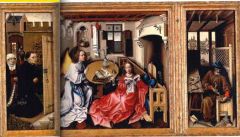
12-4
Merode Altarpiece (Triptych of the Annunciation) |
Artist or Culture: Robert Campin
Approx Date: 1425-1428 Region: Period / Style: Early Renaissance (1400-1480) |
|
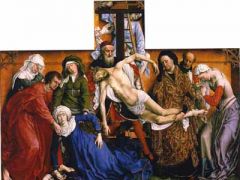
12-6
Deposition |
Artist or Culture: Rogier Van Der Weyden
Approx Date: 1443 Region: Belgium Period / Style: Early Renaissance (1400-1480) |
|
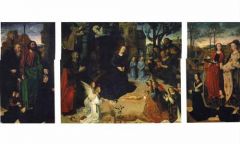
12-8
Portinari Altarpiece |
Artist or Culture: Hugo Van Der Goes
Approx Date: 1474-1476 Region: Florence Period / Style: Early Renaissance (1400-1480) |
|
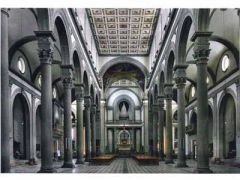
12-16
Church of San Lorenzo |
Artist or Culture: Filippo Brunelleschi
Approx Date: c. 1421 Region: Florence Period / Style: Early Renaissance (1400-1480) |
|
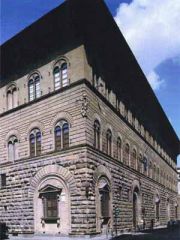
12-17
Palazzo Medici-Riccardi |
Artist or Culture: Michelozzo di Bartolomeo
Approx Date: 1446 Region: Florence Period / Style: Early Renaissance (1400-1480) |
|
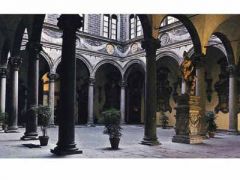
12-18
Courtyard with Sgraffito decoration, Palazzo Medici-Riccardi |
Artist or Culture: Michelozzo di Bartolomeo
Approx Date: 1446 Region: Florence Period / Style: Early Renaissance (1400-1480) |
|
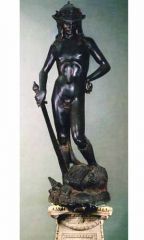
12-20
David |
Artist or Culture: Donatello
Approx Date: 1450s or 1460s Region: Florence Period / Style: Early Renaissance (1400-1480) |
|
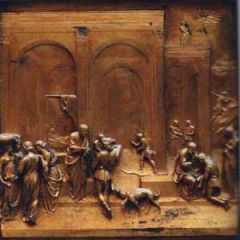
12-22
Jacob and Esau |
Artist or Culture: Lorenzo Ghiberti
Approx Date: 1435 Region: Florence Period / Style: Early Renaissance (1400-1480) |
|
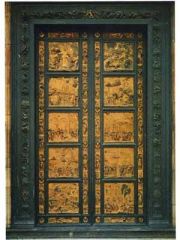
12-23
Gates of Paradise |
Artist or Culture: Lorenzo Ghiberti
Approx Date: 1425-1452 Region: Florence Period / Style: Early Renaissance (1400-1480) |
|
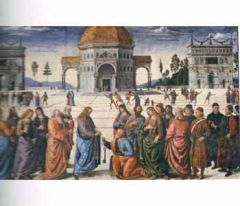
12-24
Delivery of the Keys to Saint Peter, Sistine Chapel |
Artist or Culture: Pietro Perugino
Approx Date: 1481 Region: Rome Period / Style: Early Renaissance (1400-1480) |
|
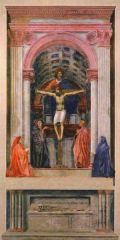
12-25
Trinity with the Virgin, Saint John the Evangelist, and Donors |
Artist or Culture: Masaccio
Approx Date: 1425-1428 Region: Florence Period / Style: Early Renaissance (1400-1480) |
|

12-29
Birth of Venus |
Artist or Culture: Sandro Botticelli
Approx Date: 1484-1486 Region: Florence Period / Style: Early Renaissance (1400-1480) |
|
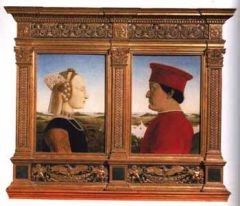
12-30
Battista Sforza (left) and Federico da Montefeltro (right) |
Artist or Culture: Piero della Francesca
Approx Date: c.1474 Region: Florence Period / Style: Early Renaissance (1400-1480) |
|

12-32
Two views of the Camera Picta |
Artist or Culture: Andrea Mantegna
Approx Date: 1465-1474 Region: Venice Period / Style: Early Renaissance (1400-1480) |
|
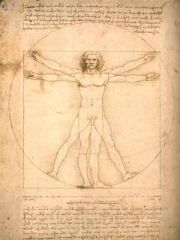
13-3
Vitruvian Man |
Artist or Culture: Leonardo da Vinci
Approx Date: c. 1490 Region: Venice Period / Style: High Renaissance (1480-1580) |
|
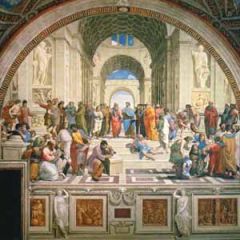
13-6
School of Athens |
Artist or Culture: Raphael
Approx Date: 1510-1511 Region: Rome Period / Style: High Renaissance (1480-1580) |
|

13-9
David |
Artist or Culture: Michelangelo
Approx Date: 1501-1504 Region: Florence Period / Style: High Renaissance (1480-1580) |
|

13-10
Sistine Chapel, Interior |
Artist or Culture: Michelangelo
Approx Date: 1475-1481 Region: Rome Period / Style: High Renaissance (1480-1580) |
|
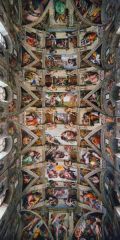
13-11
Sistine Chapel, Ceiling |
Artist or Culture: Michelangelo
Approx Date: 1508-1512 Region: Rome Period / Style: High Renaissance (1480-1580) |
|
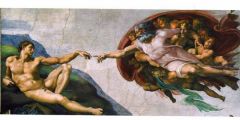
13-12
Sistine Chapel, Creation of Adam |
Artist or Culture: Michelangelo
Approx Date: 1511-1512 Region: Rome Period / Style: High Renaissance (1480-1580) |
|

13-14
St. Peter’s Basilica |
Artist or Culture: Michelangelo
Approx Date: 1546-1564 Region: Rome Period / Style: High Renaissance (1480-1580) |
|
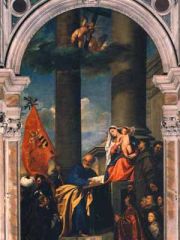
13-20
Pesaro Madonna |
Artist or Culture: Titian
Approx Date: 1519-1526 Region: Venice Period / Style: High Renaissance (1480-1580) |
|
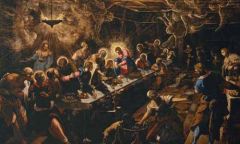
13-23
Last Supper |
Artist or Culture: Tintoretto
Approx Date: 1592-1594 Region: Venice Period / Style: High Renaissance (1480-1580) |
|
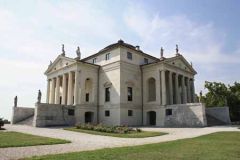
13-24
Villa Rotonda (Villa Capra) |
Artist or Culture: Andrea Palladio
Approx Date: 1550 Region: Italy Period / Style: High Renaissance (1480-1580) |
|
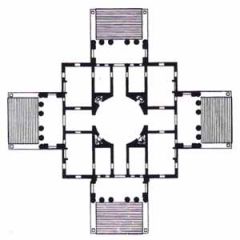
13-25
Plan of the Villa Rotonda |
Artist or Culture: Andrea Palladio
Approx Date: 1550 Region: Italy Period / Style: High Renaissance (1480-1580) |
|

13-26
Capponi Chapel, Church of Santa Felicita |
Artist or Culture: Filippo Brunelleschi
Approx Date: 1419-1423 Region: Florence Period / Style: High Renaissance (1480-1580) |
|
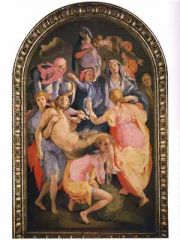
13-27
Deposition |
Artist or Culture: Jacopo da Pontormo
Approx Date: 1525-1527 Region: Florence Period / Style: High Renaissance (1480-1580) |
|
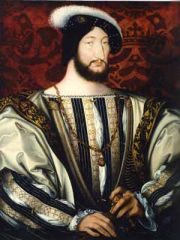
13-32
Francis I |
Artist or Culture: Jean Clouet
Approx Date: 1525-1530 Region: Paris Period / Style: High Renaissance (1480-1580) |
|
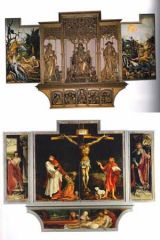
13-34
Isenheim Altarpiece |
Artist or Culture: Nikolaus Hagenauer and Matthias Grunewald
Approx Date: 1510-1515 Region: France Period / Style: High Renaissance (1480-1580) |
|
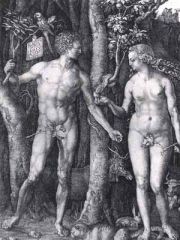
13-36
Adam and Eve |
Artist or Culture: Albrecht Durer
Approx Date: 1504 Region: Holy Roman Empire Period / Style: High Renaissance (1480-1580) |
|
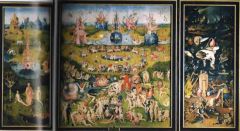
13-40
Garden of Earthly Delights |
Artist or Culture: Hieronymus Bosch
Approx Date: 1505-1515 Region: Madrid Period / Style: High Renaissance (1480-1580) |
|
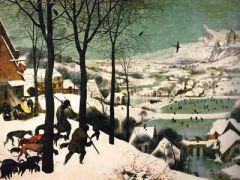
13-41
Return of the Hunters |
Artist or Culture: Pieter Bruegel the Elder
Approx Date: 1565 Region: Vienna Period / Style: High Renaissance (1480-1580) |
|
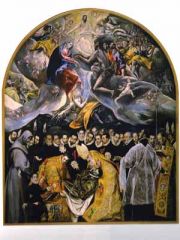
13-43
Burial of Count Orgaz |
Artist or Culture: El Greco
Approx Date: 1586 Region: Spain Period / Style: High Renaissance (1480-1580) |
|
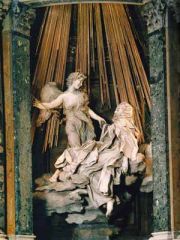
14-1
Saint Teresa of Avila in Ecstasy |
Artist or Culture: Gianlorenzo Bernini
Approx Date: 1645-1652 Region: Rome Period / Style: Baroque (1580-1680) |
|
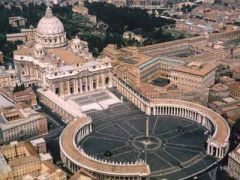
14-3
Baldacchino |
Artist or Culture: Gianlorenzo Bernini
Approx Date: 1624-1633 Region: Rome Period / Style: Baroque (1580-1680) |
|

14-5
Cornaro Chapel |
Artist or Culture: Gianlorenzo Bernini
Approx Date: 1642-1652 Region: Rome Period / Style: Baroque (1580-1680) |
|

14-7
The Triumph of the Name of Jesus and the Fall of the Damned |
Artist or Culture: Giovanni Battista
Approx Date: 1672-1685 Region: Rome Period / Style: Baroque (1580-1680) |
|
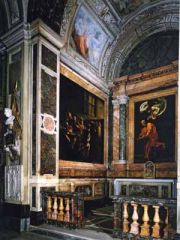
14-9
Contarelli Chapel, Church of San Luigi dei Francesi |
Artist or Culture: Caravaggio
Approx Date: 1599-1600 Region: Rome Period / Style: Baroque (1580-1680) |
|
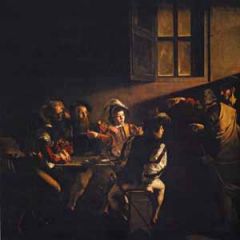
14-10
The Calling of Saint Matthew, Church of San Luigi dei Francesi |
Artist or Culture: Caravaggio
Approx Date: 1599-1600 Region: Rome Period / Style: Baroque (1580-1680) |
|
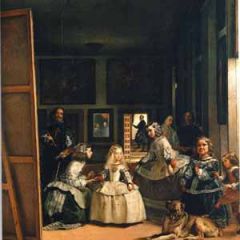
14-13
Las Meninas (The Maids of Honor) |
Artist or Culture: Diego Velazquez
Approx Date: 1656 Region: Madrid Period / Style: Baroque (1580-1680) |
|
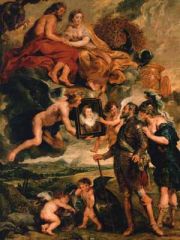
14-17
Henry IV Receiving the Portrait of Marie de’ Medici |
Artist or Culture: Peter Paul Rubens
Approx Date: 1621-1625 Region: Paris Period / Style: Baroque (1580-1680) |
|

14-19
Charles I at the Hunt |
Artist or Culture: Anthony Van Dyck
Approx Date: 1635 Region: Paris Period / Style: Baroque (1580-1680) |
|
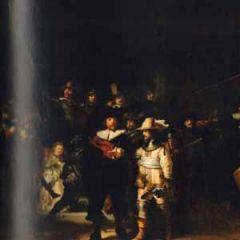
14-22
Captain Frans Banning Cocq Mustering his Company |
Artist or Culture: Rembrandt van Rijn
Approx Date: 1642 Region: Amsterdam Period / Style: Baroque (1580-1680) |
|

14-23
The Three Crosses |
Artist or Culture: Rembrandt van Rijn
Approx Date: 1653 Region: Amsterdam Period / Style: Baroque (1580-1680) |
|
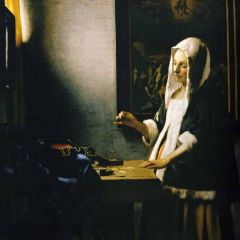
14-26
Woman Holding a Balance |
Artist or Culture: Jan Vermeer
Approx Date: c. 1664 Region: Dutch Period / Style: Baroque (1580-1680) |
|
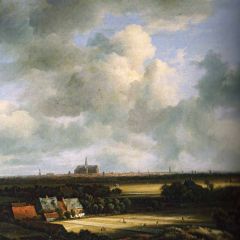
14-28
View of Haarlem from the Dunes at Overveen |
Artist or Culture: Jacob van Ruisdael
Approx Date: c. 1670 Region: Netherlands Period / Style: Baroque (1580-1680) |
|
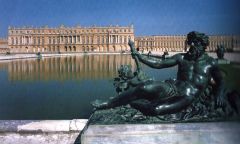
14-32
Neptune |
Artist or Culture: Jean-Baptiste Tuby
Approx Date: 1668-1685 Region: France Period / Style: Baroque (1580-1680) |
|
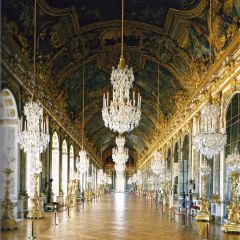
14-33
Palais de Versailles |
Artist or Culture: Jules Hardouin-Mansart and Charles Le Brun
Approx Date: 1668-1685 Region: France Period / Style: Baroque (1580-1680) |
|
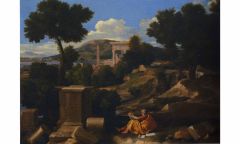
14-34
Landscape with Saint John on Patmos |
Artist or Culture: Nicolas Poussin
Approx Date: 1640 Region: France Period / Style: Late Baroque (1680-1780) |
|
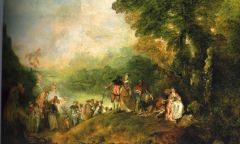
14-36
The Pilgrimage to Cythera |
Artist or Culture: Jean-Antoine Watteau
Approx Date: 1717 Region: Paris Period / Style: Late Baroque (1680-1780) |
|

14-37
The Progress of Love |
Artist or Culture: Jean-Honore Fragonard The Meeting
Approx Date: 1771-1773 Region: France Period / Style: Late Baroque (1680-1780) |

